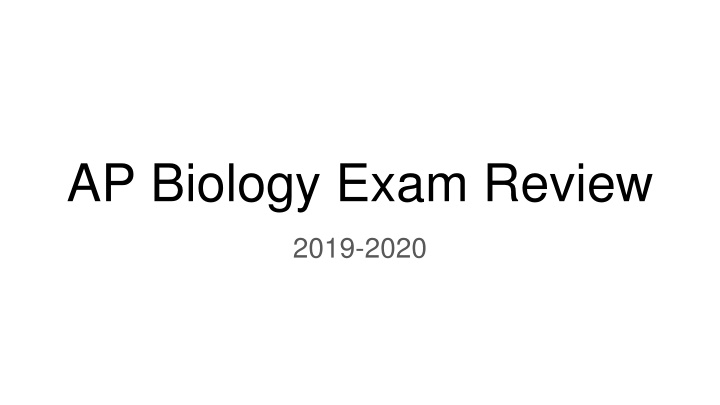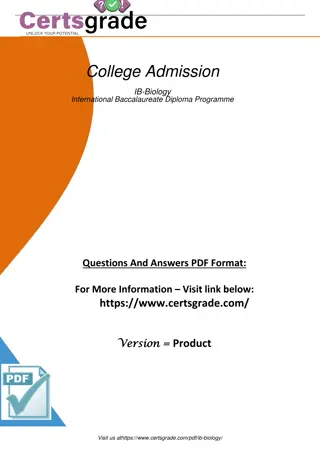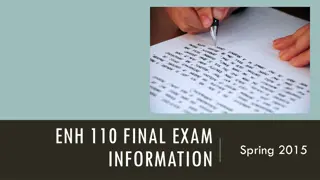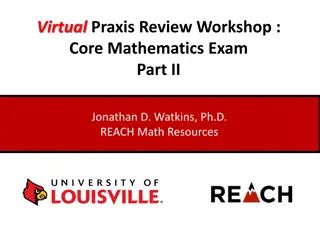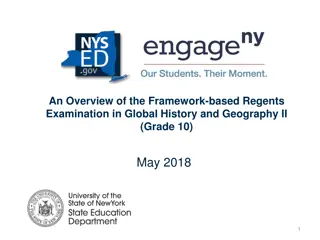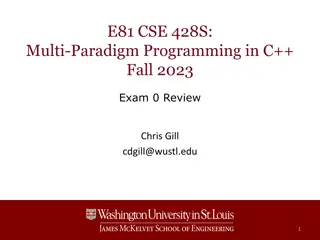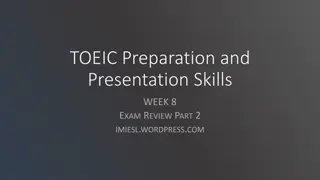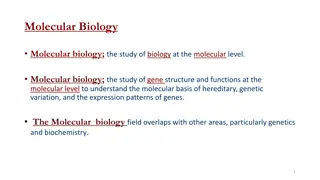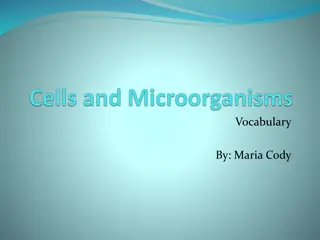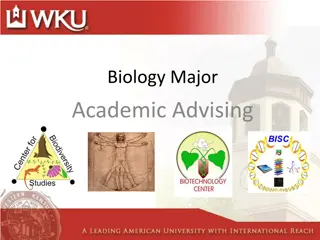AP Biology Exam Review 2019-2020 Overview
This Review provides detailed information for the AP Biology Exam 2019-2020, including exam date, time, location, and content overview for Units 1-8. It covers major topics, Bozeman videos, review materials, vocabulary, and essential questions for each unit. Resources such as practice questions, review videos, and vocabulary terms are available for thorough exam preparation.
Download Presentation

Please find below an Image/Link to download the presentation.
The content on the website is provided AS IS for your information and personal use only. It may not be sold, licensed, or shared on other websites without obtaining consent from the author.If you encounter any issues during the download, it is possible that the publisher has removed the file from their server.
You are allowed to download the files provided on this website for personal or commercial use, subject to the condition that they are used lawfully. All files are the property of their respective owners.
The content on the website is provided AS IS for your information and personal use only. It may not be sold, licensed, or shared on other websites without obtaining consent from the author.
E N D
Presentation Transcript
AP Biology Exam Review 2019-2020
2020 Exam Information Date: To Be Determined Time: To Be Determined Location: To Be Determined Exam Details One 45 minute exam FRQs only - no multiple choice Units 1-6 only General Exam Prep AP Classroom Review Channel - review videos made by AP will be added here weekly AP Biology Review Videos - review videos made by AP Biology teachers this year Bozeman Exam Review, Bozeman Data Collection, Bozeman Graphing Quizlet Vocab Kahoot
Review Introduction Throughout these slides you will find the following items for each unit: Major topics - Use this as a general guide for what each unit is about Bozeman videos - Watch as many as possible to get a refresher on specific topics Review Material: Practice MC and FRQ questions available now in AP Classroom Review videos from AP Classroom and other AP Biology teachers will be posted here as they become available Practice FRQs from previous exams Vocabulary terms to know Essential questions to answer
Units 1. Chemistry of Life 2. Cell Structure and Function 3. Cellular Energetics 4. Cell Communication and Cell Cycle 5. Heredity 6. Gene Expression and Regulation 7. Natural Selection 8. Ecology
Unit 1: Chemistry of Life Major Topics Bozeman Videos Structure of water and hydrogen bonding Elements of life Biological molecules Nucleic acids Water 1 and Water 2 Biological molecules Carbs Lipids Proteins Nucleic acids Review Material Practice MC and FRQ available now in AP Classroom FRQs from previous exams - Organized by unit, links to keys are on the second page AP Classroom Review Channel - review videos made by AP will be added here weekly AP Biology Review Videos - review videos made by AP Biology teachers this year
Chemistry of Life Continued Vocabulary Atom Hydrogen Bond Polar Adhesion Cohesion Surface Tension Synthesis Hydrolysis Essential Element Macromolecule Dehydration Nonpolar Monomer Phospholipids Saturated Fats Unsaturated Fats Deoxyribose Nitrogenous Base Nucleic Acid Nucleotide Ribonucleic Acid Ribose Carbohydrates Deoxyribonucleic Acid (DNA) Lipid Phosphate Protein Polymer Amino Acid Amino Terminus Carboxyl Terminus Hydrophilic Synthesis 5 Subunit R group Hydrophobic Covalent Bond 3 Antiparallel Double Helix Alpha Helix Beta-Sheet Peptide Polypeptide Primary Structure
Chemistry of Life Continued Essential Questions 1. Explain how the properties of water that result from its polarity and hydrogen bonding affect its biological function. 2. Describe the composition of macromolecules required by living organisms. 3. Describe the properties of the monomers and the type of bonds that connect the monomers in biological macromolecules. 4. Explain how a change in the subunits of a polymer may lead to changes in structure or function of the macromolecule. 5. Describe the structural similarities and differences between DNA and RNA.
Unit 2: Cell Structure and Function Major Topics Bozeman Videos Review Material Cell structure and function Cell size Plasma membrane Membrane permeability and transport Facilitated diffusion Osmoregulation Cell compartmentalization Cell basics, cell organelles, cell membrane, cell compartmentalization Diffusion/osmosis Water potential Practice MC and FRQ available now in AP Classroom FRQs from previous exams - Organized by unit, links to keys are on the second page AP Classroom Review Channel - review videos made by AP will be added here weekly AP Biology Review Videos - review videos made by AP Biology teachers this year
Cell Structure and Function Continued Vocabulary Chloroplast Endoplasmic Reticulum Golgi Complex Lysosome Membrane-Bound Mitochondrion Ribosome Vacuole Organelles Apoptosis Intracellular Transport Turgor Pressure Plasma Membrane Glycolipid Surface Area to Volume Ratio Fluid Mosaic Model Glycoprotein Channel Protein Transport Protein Active Transport Endocytosis Aqueous Steroid Selective Permeability Cell Wall Vesicle Concentration Gradient Exocytosis Passive Transport Ion Polarization Facilitated Diffusion ATP Synthase Enzyme Hypertonic Hypotonic Isotonic Osmoregulation Osmosis Solute Solvent Tonicity Water Potential Eukaryotic Homeostasis Compartmentalization
Cell Structure and Function Continued Essential Questions 1. Describe the structure and/or function of subcellular components and organelles. 2. Explain how subcellular components and organelles contribute to the function of the cell. 3. Describe the structural features of a cell that allow organisms to capture, store, and use energy. 4. Explain the effect of surface area-to-volume ratios on the exchange of materials between cells or organisms and the environment. 5. Explain how specialized structures and strategies are used for the efficient exchange of molecules to the environment. 6. Describe the roles of each of the components of the cell membrane in maintaining the internal environment of the cell. 7. Describe the Fluid Mosaic Model of cell membranes. 8. Explain how the structure of biological membranes influences selective permeability. 9. Describe the role of the cell wall in maintaining cell structure and function. 10.Describe the mechanisms that organisms use to maintain solute and water balance. 11.Describe the mechanisms that organisms use to transport large molecules across the plasma membrane. 12.Explain how the structure of a molecule affects its ability to pass through the plasma membrane. 13.Explain how concentration gradients affect the movement of molecules across membranes. 14.Explain how osmoregulatory mechanisms contribute to the health and survival of organisms. 15.Describe the processes that allow ions and other molecules to move across membranes. 16.Describe the membrane-bound structures of the eukaryotic cell. 17.Explain how internal membranes and membrane-bound organelles contribute to compartmentalization of eukaryotic cell functions. 18.Describe similarities and/or differences in compartmentalization between prokaryotic and eukaryotic cells. 19.Describe the relationship between the functions of endosymbiotic organelles and their free-living ancestral counterparts.
Unit 3: Cellular Energetics Major Topics Bozeman Videos Review Material Enzyme structure Enzyme catalysis Environmental impacts of enzymes Cellular energy Photosynthesis Cellular respiration Fitness Enzyme basics, enzyme catalysis Cellular energy Photosynthesis, cellular respiration Practice MC and FRQ available now in AP Classroom FRQs from previous exams - Organized by unit, links to keys are on the second page AP Classroom Review Channel - review videos made by AP will be added here weekly AP Biology Review Videos - review videos made by AP Biology teachers this year
Cellular Energetics Continued Vocabulary Chemical Reaction Enzyme Substrate Activation Energy Catalysis Catalysts pH Competitive Inhibition Denaturation Noncompetitive Inhibition Cyanobacteria Chemistry Oxidation NADPH/NADP+ Electron Inorganic Organic Chemistry Cytosol Stimuli Aerobic Adenosine Diphosphate (ADP) Anaerobic Cellular Respiration Electrochemical Gradient Electron Acceptor Electron Carrier Endothermic Fermentation Glycolysis Lactic Acid NADH/NAD+ Photophosphorylation Proton Oxidative Phosphorylation Pyruvate Coenzyme ATP Synthesis Adenosine TriPhosphate (ATP) Calvin Cycle Chlorophyll Krebs Cycle Grana Electron Transport Chain Light-Dependent Reactions Photosynthesis Photosystems
Cellular Energetics Continued Essential Questions 1. Describe the properties of enzymes. 2. Explain how enzymes affect the rate of biological reactions. 3. Explain how changes to the structure of an enzyme may affect its function. 4. Explain how the cellular environment affects enzyme activity. 5. Describe the role of energy in living organisms. 6. Describe the photosynthetic processes that allow organisms to capture and store energy. 7. Explain how cells capture energy from light and transfer it to biological molecules for storage and use. 8. Describe the processes that allow organisms to use energy stored in biological macromolecules. 9. Explain how cells obtain energy from biological macromolecules in order to power cellular functions. 10.Explain the connection between variation in the number and types of molecules within cells to the ability of the organism to survive and/or reproduce in different environments.
Unit 4: Cell Communication and Cell Cycle Major Topics Bozeman Videos Review Material Cell communication Signal transduction **Feedback Cell cycle and regulation Cell communication Signal transduction **Feedback Cell cycle and regulation Practice MC and FRQ available now in AP Classroom FRQs from previous exams - Organized by unit, links to keys are on the second page AP Classroom Review Channel - review videos made by AP will be added here weekly AP Biology Review Videos - review videos made by AP Biology teachers this year ** We did not discuss Feedback yet. Please be sure to watch this video and answer Essential Question 8-10. Let me know if you have questions.
Cell Communication and Cell Cycle Continued Vocabulary Target Cell Phosphorylation Receptor Protein Secondary Messenger Signal Transduction Ligand Signal Amplification Response Feedback Positive Feedback Negative Feedback Cell Cycle Mitosis Interphase Asexual Reproduction Cancer Anaphase Cyclin Prophase Metaphase Telophase Cytokinesis G1/S/G2 Phases Spindle Fibers Cyclin Dependent Kinase Kinase Receptor Amplification Homeostasis
Cell Communication and Cell Cycle Continued Essential Questions 1. Describe the ways that cells can communicate with one another. 2. Explain how cells communicate with one another over short and long distances. 3. Describe the components of a signal transduction pathway. 4. Describe the role of components of a signal transduction pathway in producing a cellular response. 5. Describe the role of the environment in eliciting a cellular response. 6. Describe the different types of cellular responses elicited by a signal transduction pathway. 7. Explain how a change in the structure of any signaling molecule affects the activity of the signaling pathway. 8. **Describe positive and/or negative feedback mechanisms. 9. **Explain how negative feedback helps to maintain homeostasis. 10.**Explain how positive feedback affects homeostasis. 11.Describe the events that occur in the cell cycle. 12.Explain how mitosis results in the transmission of chromosomes from one generation to the next. 13.Describe the role of checkpoints in regulating the cell cycle. 14.Describe the effects of disruptions to the cell cycle on the cell or organism. ** We did not discuss Feedback yet. Please be sure to watch the Bozeman video and answer Essential Question 8-10. Let me know if you have questions.
Unit 5: Heredity Major Topics Bozeman Videos Review Material Meiosis Genetic diversity Mendelian genetics Non-Mendelian genetics Environmental effects on phenotype Chromosomal inheritance Meiosis Mendelian genetics, Non-Mendelian genetics, chromosomal inheritance Genotype and phenotype Practice MC and FRQ available now in AP Classroom FRQs from previous exams - Organized by unit, links to keys are on the second page AP Classroom Review Channel - review videos made by AP will be added here weekly AP Biology Review Videos - review videos made by AP Biology teachers this year
Heredity Continued Vocabulary Meiosis Gamete Diploid (2n) Daughter Cell Chromosomes Haploid (1n) Homologous Chromosomes Chromatid Crossing Over Sexual Reproduction Fertilization Conserved Law of Independent Assortment Law of Segregation Zygote Trait Allele Genetic Linkage Genotype Phenotype Sex-Linked Trait Nondisjunction PMAT PMAT 2 Punnett Square Incomplete Dominance Complete Dominance Codominance Dominant Recessive Allele Homozygous Heterozygous
Heredity Continued Essential Questions 1. Explain how meiosis results in the transmission of chromosomes from one generation to the next. 2. Describe similarities and/ or differences between the phases and outcomes of mitosis and meiosis. 3. Explain how the process of meiosis generates genetic diversity. 4. Explain how shared, conserved, fundamental processes and features support the concept of common ancestry for all organisms. 5. Explain the inheritance of genes and traits as described by Mendel s laws. 6. Explain deviations from Mendel s model of the inheritance of traits. 7. Explain how the same genotype can result in multiple phenotypes under different environmental conditions. 8. Explain how chromosomal inheritance generates genetic variation in sexual reproduction.
Unit 6: Gene Expression and Regulation Major Topics Bozeman Videos Review Material DNA and RNA structure Replication Transcription Translation Regulation of gene expression Mutations Biotechnology DNA/RNA 1, DNA/RNA 2, replication Transcription/translation Gene regulation Mutations Biotechnology Practice MC and FRQ available now in AP Classroom FRQs from previous exams - Organized by unit, links to keys are on the second page AP Classroom Review Channel - review videos made by AP will be added here weekly AP Biology Review Videos - review videos made by AP Biology teachers this year
Gene Expression and Regulation Continued Vocabulary DNA Replication Semiconservative Replication Fork Transcription Template Strand Intron Exon Splicing Translation Codon Virus Histone Operon Gene Expression Cell Differentiation Cell Specialization Epigenetics Transcription Factor Promoter Triploidy Operator Repressor Conjugation Regulatory Gene Biotechnology Genetic Engineering Electrophoresis DNA Sequencing Deoxyribose Nitrogenous Base Nucleic Acid Nucleotide Polymerase Chain Reaction (PCR) 5 Helicase Ligase Ribosome Ribonucleic Acid Ribose 3 Antiparallel Double Helix Topoisomerase Okazaki Fragment Polymerase
Gene Expression and Regulation Continued Essential Questions 1. Describe the structures involved in passing hereditary information from one generation to the next. 2. Describe the characteristics of DNA that allow it to be used as the hereditary material. 3. Describe the mechanisms by which genetic information is copied for transmission between generations. 4. Describe the mechanisms by which genetic information flows from DNA to RNA to protein. 5. Describe how the phenotype of an organism is determined by its genotype. 6. Describe the types of interactions that regulate gene expression. 7. Explain how the location of regulatory sequences relates to their function. 8. Explain how the binding of transcription factors to promoter regions affects gene expression and/or the phenotype of the organism. 9. Explain the connection between the regulation of gene expression and phenotypic differences in cells and organisms. 10.Describe the various types of mutation. 11.Explain how changes in genotype may result in changes in phenotype. 12.Explain how alterations in DNA sequences contribute to variation that can be subject to natural selection. 13.Explain the use of genetic engineering techniques in analyzing or manipulating DNA.
Units 7 and 8 are not on the exam this year! DO NOT REVIEW THE SLIDES BEYOND THIS POINT! They are only in here for future use!
Unit 7: Natural Selection Major Topics Review Material Bozeman Videos Natural selection, Artificial/Natural selection Population genetics Hardy-Weinberg Evidence of evolution Phylogeny Speciation Extinction Origin of life Natural selection Artificial selection Population genetics Hardy-Weinberg Equilibrium Evidence of evolution Common ancestry Phylogeny Speciation Extinction Variation in populations Origin of life on Earth Practice MC and FRQ available now in AP Classroom FRQs from previous exams - Organized by unit, links to keys are on the second page AP Classroom Review Channel - review videos made by AP will be added here weekly AP Biology Review Videos - review videos made by AP Biology teachers this year
Natural Selection Continued Vocabulary Natural Selection Pressure Reproductive Isolation Evolution Adaptive Radiation Evolution Evolutionary Fitness Selective Speciation Allopatric Sympatric Divergent Nonrandom Mating Extinction Species Diversity Ecosystems Niche RNA World Hypothesis Convergent Evolution Mutation Population Genetic Drift Bottleneck Effect Founder Effect Migration Morphology Hardy-Weinberg Equilibrium Fossil Vestigial Structure Phylogenetic Tree Phylogeny Cladogram Molecular Clock Out-Group Lineage
Natural Selection Continued Essential Questions 1. Describe the causes of natural selection. 2. Explain how natural selection affects populations. 3. Describe the importance of phenotypic variation in a population. 4. Explain how humans can affect diversity within a population. 5. Explain how random occurrences affect the genetic makeup of a population. 6. Describe the role of random processes in the evolution of specific populations. 7. Describe the change in the genetic makeup of a population over time. 8. Describe the conditions under which allele and genotype frequencies will change in populations. 9. Explain the impacts on the population if any of the conditions of Hardy- Weinberg are not met. 10.Describe the types of data that provide evidence for evolution. 11.Explain how morphological, biochemical, and geological data provide evidence that organisms have changed over time. 12.Describe the fundamental molecular and cellular features shared across all domains of life, which provide evidence of common ancestry. 13.Describe structural and functional evidence on cellular and molecular levels that provides evidence for the common ancestry of all eukaryotes. 14.Explain how evolution is an ongoing process in all living organisms. 15.Describe the types of evidence that can be used to infer an evolutionary relationship. 16.Explain how a phylogenetic tree and/or cladogram can be used to infer evolutionary relatedness. 17.Describe the conditions under which new species may arise. 18.Describe the rate of evolution and speciation under different ecological conditions. 19.Explain the processes and mechanisms that drive speciation. 20.Describe factors that lead to the extinction of a population. 21.Explain how the risk of extinction is affected by changes in the environment. 22.Explain species diversity in an ecosystem as a function of speciation and extinction rates. 23.Explain how extinction can make new environments available for adaptive radiation. 24.Explain how the genetic diversity of a species or population affects its ability to withstand environmental pressures. 25.Describe the scientific evidence that provides support for models of the origin of life on Earth.
Unit 8: Ecology Major Topics Responses to the environment Energy flow through ecosystems Population ecology Effect of density of populations Community ecology Biodiversity Disruptions to ecosystems Bozeman Videos Response to environment Energy flow Population ecology Community ecology Biodiversity Disruptions to ecosystems Review Material Practice MC and FRQ available now in AP Classroom FRQs from previous exams - Organized by unit, links to keys are on the second page AP Classroom Review Channel - review videos made by AP will be added here weekly AP Biology Review Videos - review videos made by AP Biology teachers this year
Ecology Continued Vocabulary Abiotic Factor Adaptation Biome Carbon Cycle Community Decomposer Age Structure Biodiversity Biotic Factor Carrying Capacity Climate Change Conservation Density-Dependent Factor Food Chain Food Web Global Warming Greenhouse Effect Gross Primary Productivity Habitat Hydrologic Cycle Imprinting Interspecific Competition Intraspecific Competition K-Selection Keystone Species Nitrogen Cycle Parasite Population Growth Predator Photoautotroph Population Pollution Primary Consumer Rate of Increase R-Selection Saprophyte Detritivore Distribution Niche Primary Succession Secondary Succession Ecosystem Limiting Factor Endangered Species Exponential Growth
Ecology Continued Essential Questions 1. Explain how the behavioral and/or physiological response of an organism is related to changes in internal or external environment. 2. Explain how the behavioral responses of organisms affect their overall fitness and may contribute to the success of the population. 3. Describe the strategies organisms use to acquire and use energy. 4. Explain how changes in energy availability affect populations and ecosystems. 5. Explain how the activities of autotrophs and heterotrophs enable the flow of energy within an ecosystem. 6. Describe factors that in influence growth dynamics of populations. 7. Explain how the density of a population affects and is determined by resource availability in the environment. 8. Describe the structure of a community according to its species composition and diversity. 9. Explain how interactions within and among populations influence community structure. 10.Explain how community structure is related to energy availability in the environment. 11.Describe the relationship between ecosystem diversity and its resilience to changes in the environment. 12.Explain how the addition or removal of any component of an ecosystem will affect its overall short-term and long-term structure. 13.Explain the interaction between the environment and random or preexisting variations in populations. 14.Explain how invasive species affect ecosystem dynamics. 15.Describe human activities that lead to changes in ecosystem structure and/or dynamics. 16.Explain how geological and meteorological activity leads to changes in ecosystem structure and/or dynamics.
